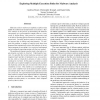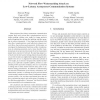SP
2007
IEEE
14 years 9 months ago
2007
IEEE
SP
2007
IEEE
14 years 9 months ago
2007
IEEE
Malicious code (or malware) is defined as software that fulfills the deliberately harmful intent of an attacker. Malware analysis is the process of determining the behavior and ...
SP
2007
IEEE
14 years 9 months ago
2007
IEEE
Law enforcement agencies need the ability to conduct electronic surveillance to combat crime, terrorism, or other malicious activities exploiting the Internet. However, the prolif...
SP
2007
IEEE
14 years 9 months ago
2007
IEEE
Many proposed low-latency anonymous communication systems have used various flow transformations such as traffic padding, adding cover traffic (or bogus packets), packet droppi...
SP
2007
IEEE
14 years 9 months ago
2007
IEEE
Information-flow security policies are an appealing way of specifying confidentiality and integrity policies in information systems. Most previous work on language-based securit...
SP
2007
IEEE
14 years 9 months ago
2007
IEEE
We present a new technique that enables software recovery in legacy applications by retrofitting exception-handling capabilities, error virtualization using rescue points. We int...
SP
2007
IEEE
14 years 9 months ago
2007
IEEE
We design an encryption scheme called Multi-dimensional Range Query over Encrypted Data (MRQED), to address the privacy concerns related to the sharing of network audit logs and v...
SP
2007
IEEE
14 years 9 months ago
2007
IEEE
We evaluate website authentication measures that are designed to protect users from man-in-the-middle, ‘phishing’, and other site forgery attacks. We asked 67 bank customers t...
SP
2007
IEEE
14 years 9 months ago
2007
IEEE
To achieve end-to-end security, traditional machine-to-machine security measures are insufficient if the integrity of the human-computer interface is compromised. GUI logic flaws ...
SP
2007
IEEE
14 years 9 months ago
2007
IEEE
TCB Code Execution (Extended Abstract)∗ Jonathan M. McCune, Bryan Parno, Adrian Perrig, Michael K. Reiter, and Arvind Seshadri Carnegie Mellon University We propose an architect...





